2015 MERCEDES-BENZ SLS AMG GT ROADSTER ESP
[x] Cancel search: ESPPage 30 of 290
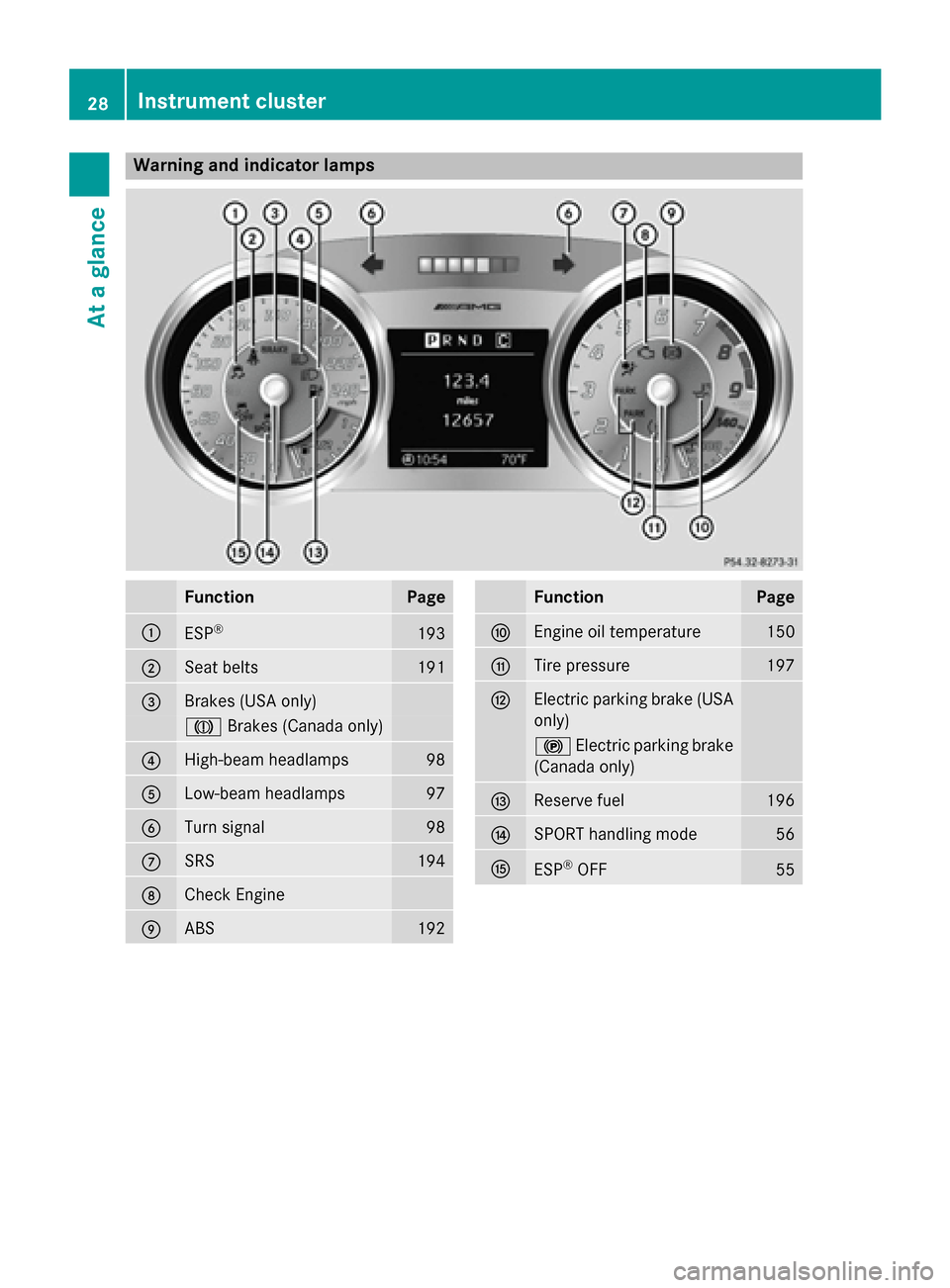
Warning and indicator lamps
Function Page
0043
ESP
® 193
0044
Seat belts 191
0087
Brakes (USA only)
004D
Brakes (Canada only) 0085
High-beam headlamps 98
0083
Low-beam headlamps 97
0084
Turn signal 98
006B
SRS 194
006C
Check Engine
006D
ABS 192 Function Page
006E
Engine oil temperature 150
006F
Tire pressure 197
0070
Electric parking brake (USA
only) 0024
Electric parking brake
(Canada only) 0071
Reserve fuel 196
0072
SPORT handling mode 56
0073
ESP
®
OFF 5528
Instrument clusterAt
ag lance
Page 33 of 290
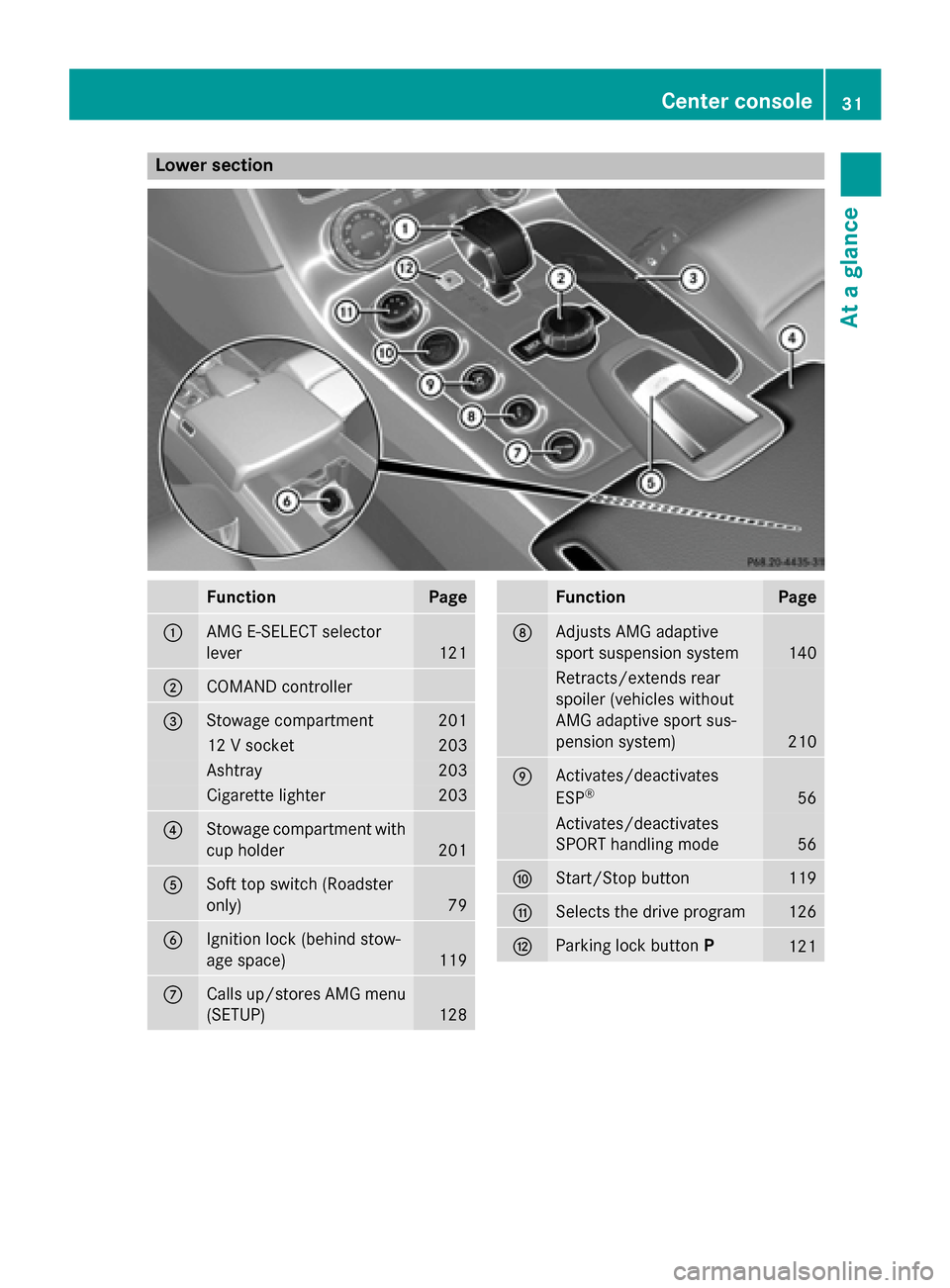
Lower section
Function Page
0043
AM
GE -SELEC Tselector
lever 121
0044
COMAND controller
0087
Stowage compartment 201
12
Vsocket 203
Ashtray 203
Cigarette lighter 203
0085
Stowage compartmen
twith
cup holder 201
0083
Sof
ttop switch (Roadster
only) 79
0084
Ignitio
nlock (behin dstow-
age space) 119
006B
Calls up/stores AM
Gmenu
(SETUP) 128 Function Page
006C
Adjust
sAMG adaptive
spor tsuspension system 140
Retracts/extend
srear
spoile r(vehicle swithout
AM Ga daptive spor tsus-
pension system) 210
006D
Activates/deactivates
ESP
® 56
Activates/deactivates
SPORT handlin
gmode 56
006E
Start/Sto
pbutton 119
006F
Select
sthe driv eprogram 126
0070
Parking lock button
P 121Center console
31Atag lance
Page 41 of 290
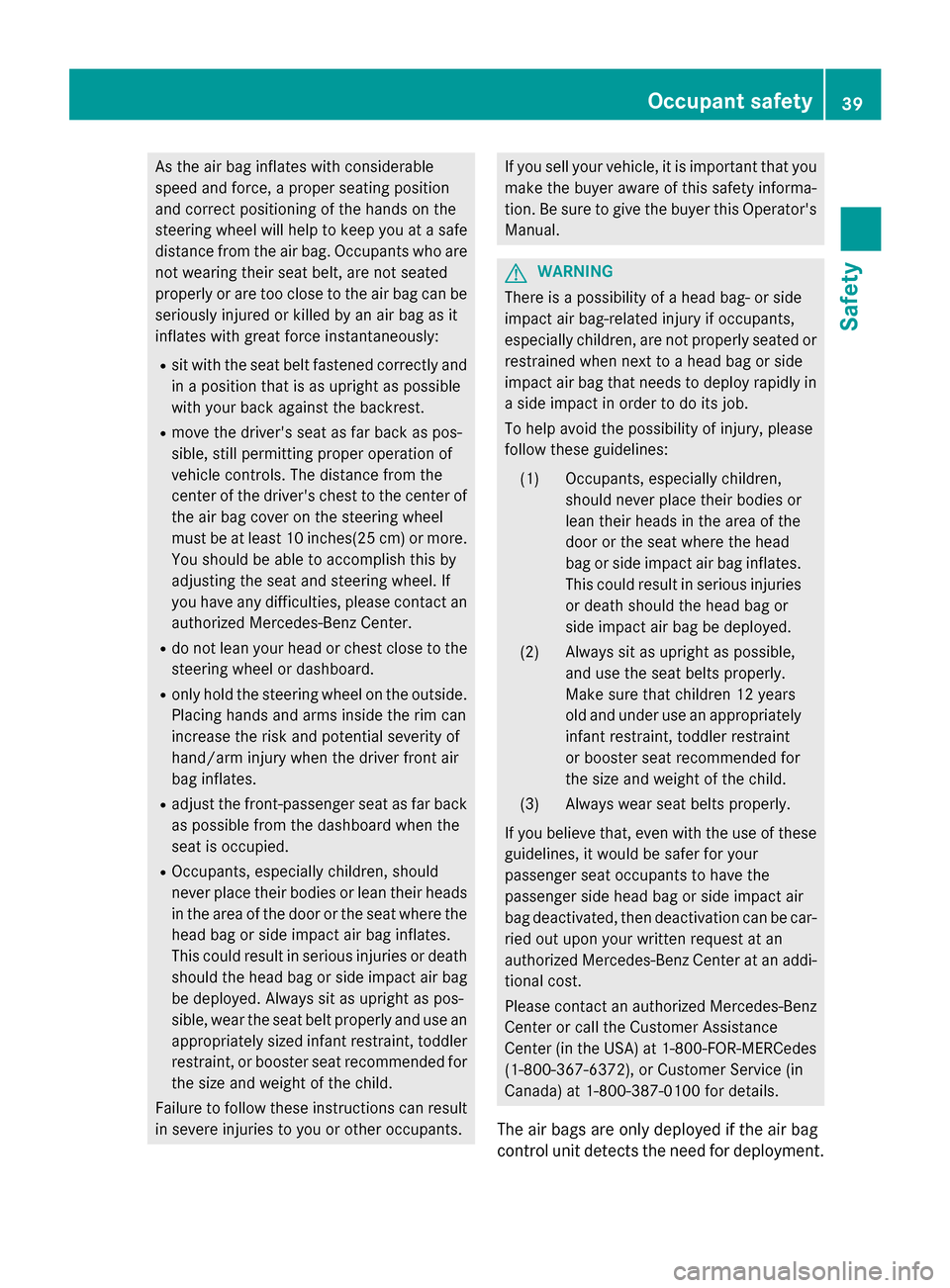
As the ai
rbag inflate swithc onsiderable
speed and force, aprope rseating position
and correct positioning of the hands on the
steering whee lwillh elptok eepy ou atas afe
distance from the ai rbag.O ccupants wh oare
not wearing thei rseatb elt, ar enot seated
properly or ar etoo close to the ai rbag can be
seriously injured or kille dbyanairba gasit
inflate swithg reat forc einstantaneously:
R sitw itht he sea tbeltf astene dcorrectl yand
in ap osit iont hatisasu pright as possible
with your back against the backrest.
R move the driver's sea tasfar back as pos-
sible, still permitting prope roperatio nof
vehicl econtrols .The distance from the
cente rofthe driver's chest to the cente rof
the ai rbag cove ront he steering wheel
must be at leas t10inches(25 cm) or more.
Yo us houl dbea bletoa ccomplis hthisby
adjusting the sea tand steering wheel. If
yo uh avea ny difficulties, please contact an
authorize dMercedes-Benz Center.
R do not lean your hea dorchest close to the
steering whee lordashboard.
R onl yholdt he steering whee lonthe outside.
Placing hands and arms insid ethe rim can
increase the ris kand potential severity of
hand/arm injury when the driver front air
ba ginflates.
R adjus tthe front-passenger sea tasfar back
as possibl efrom the dashboard when the
sea tiso ccupied.
R Occupants, especially children, should
neve rplace thei rbodies or lean thei rheads
in the area of the door or the sea twhere the
hea dbagor side impact ai rbag inflates.
Thi scould resul tinserious injurie sordeath
shoul dthe hea dbagor side impact ai rbag
be deployed .Alway ssitas upright as pos-
sible, wear the sea tbeltp roperly and us ean
appropriately sized infant restraint, toddler
restraint, or booste rsea trecommende dfor
the size and weight of the child.
Failure to follo wthes einstructions can result
in severe injurie stoyouor othe roccupants. If yo
uselly ou rvehicle, it is important tha tyou
make the buye raware of thissafety informa-
tion. Be sure to give the buye rthisO perator's
Manual. G
WARNING
There is apossibility of aheadb ag-ors ide
impact ai rbag-related injury if occupants,
especially children, ar enot properly seated or
restrained when next to aheadb agor side
impact ai rbag tha tneeds to deploy rapidl yin
as idei mpact in order to do its job.
To hel pavoid the possibility of injury ,please
follo wthes eguideli nes:
(1) Occupants, especially children, shouldneve rplace thei rbodies or
lean thei rheads in the area of the
door or the sea twhere the head
ba gors idei mpact ai rbag inflates.
Thi scould resul tinserious injuries
or death shoul dthe hea dbagor
side impact ai rbag be deployed.
(2) Alway ssitas upright as possible,
and us ethe sea tbelts properly.
Make sure tha tchildren 12 years
ol da nd under us eanappropriately
infant restraint, toddle rrestraint
or booste rseatrecommende dfor
the size and weight of the child.
(3) Alway swears eatb elts properly.
If yo ubeliev ethat, eve nwitht he us eofthese
guidelines, it woul dbesafer for your
passenge rseato ccupants to have the
passenge rsideh eadb agor side impact air
ba gd eactivated ,then deactivatio ncan be car-
rie do utupon your written request at an
authorize dMercedes-Benz Center at an addi-
tional cost.
Please contact an authorize dMercedes-Benz
Center or cal lthe Customer Assistance
Center (i nthe USA) at 1-800-FOR-MERCedes
(1-800-367-6372) ,orCustomer Service (in
Canada) at 1-800-387-010 0for details.
The ai rbagsa reonl ydeploye difthe ai rbag
contro lunitd etects the nee dfor deployment. Occupant safety
39Safety Z
Page 46 of 290
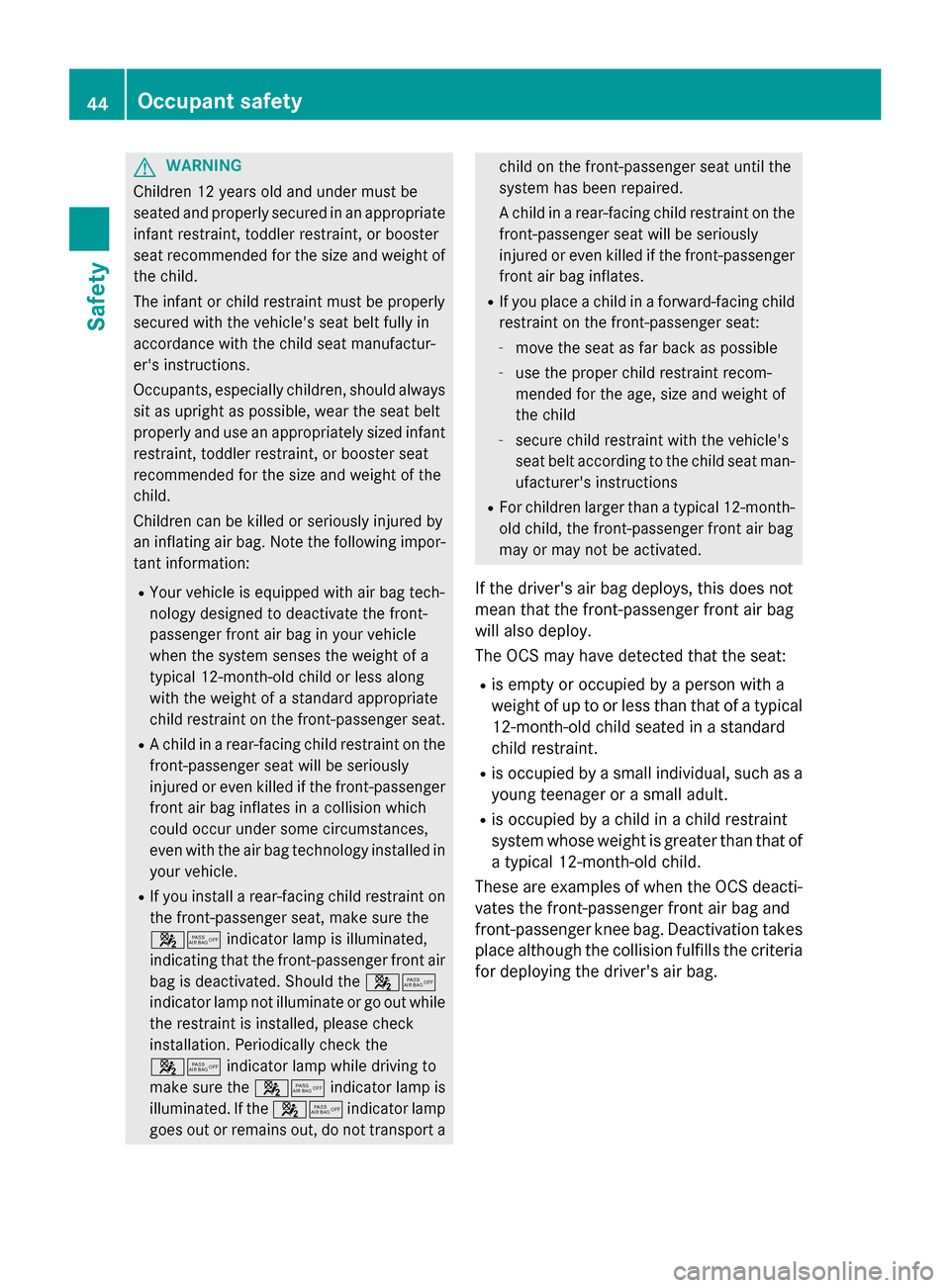
G
WARNING
Childre n12years old and under must be
seated and properly secure dinanappropriate
infant restraint, toddle rrestraint, or booster
seat recommende dfor the size and weight of
the child.
The infant or child restraint must be properly
secure dwith the vehicle's seat beltf ullyin
accordance with the child seat manufactur-
er's instructions.
Occupants, especially children, should always
sit as upright as possible,w earthe seat belt
properly and use an appropriately sized infant
restraint, toddler restraint, or booster seat
recommende dfor the size and weight of the
child.
Childre ncan be kille dorseriouslyi njured by
an inflating air bag.N ote the following impor-
tant information:
R Yourv ehicleise quipped with air bag tech-
nology designed to deactivate the front-
passenger front air bag in yourv ehicle
when the system senses the weight of a
typical 12-month-old child or less along
with the weight of astandard appropriate
child restraint on the front-passenge rseat.
R Ac hild in arear-facing child restraint on the
front-passenge rseat willbes eriously
injured or even kille difthe front-passenger
front air bag inflates in acollision which
coul doccur under some circumstances,
even with the air bag technology installed in yourv ehicle.
R If you install arear-facing child restraint on
the front-passenge rseat, make sure the
00730074 indicator lamp is illuminated,
indicating that the front-passenge rfront air
bag is deactivated. Shoul dthe 00730074
indicator lamp not illuminate or go out while the restraint is installed, please check
installation. Periodically check the
00730074 indicator lamp while driving to
make sure the 00730074indicator lamp is
illuminated. If the 00730074indicator lamp
goes out or remains out, do not transport a child on the front-passenge
rseat until the
system has been repaired.
Ac hild in arear-facing child restraint on the
front-passenge rseat willbes eriously
injured or even kille difthe front-passenger
front air bag inflates.
R If you place achild in aforward-facing child
restraint on the front-passenge rseat:
- move the seat as far back as possible
- use the prope rchild restraint recom-
mended for the age,s ize and weight of
the child
- secure child restraint with the vehicle's
seat belta ccording to the child seat man-
ufacturer's instructions
R For children larger than atypical 12-month-
old child ,the front-passenge rfront air bag
may or may not be activated.
If the driver's air bag deploys,t his does not
mean that the front-passenge rfront air bag
willa lsod eploy.
The OCS may have detected that the seat:
R is empty or occupied by aperso nwith a
weight of up to or less than that of atypical
12-month-old child seated in astandard
child restraint.
R is occupied by asmal lindividual, such as a
young teenage rorasmalladult.
R is occupied by achild in achild restraint
system whos eweight is greater than that of
at ypical 12-month-old child.
These are examples of when the OCS deacti- vates the front-passenge rfront air bag and
front-passenge rknee bag.D eactivation takes
place although the collision fulfills the criteria for deploying the driver's air bag. 44
Occupant safetySafety
Page 53 of 290
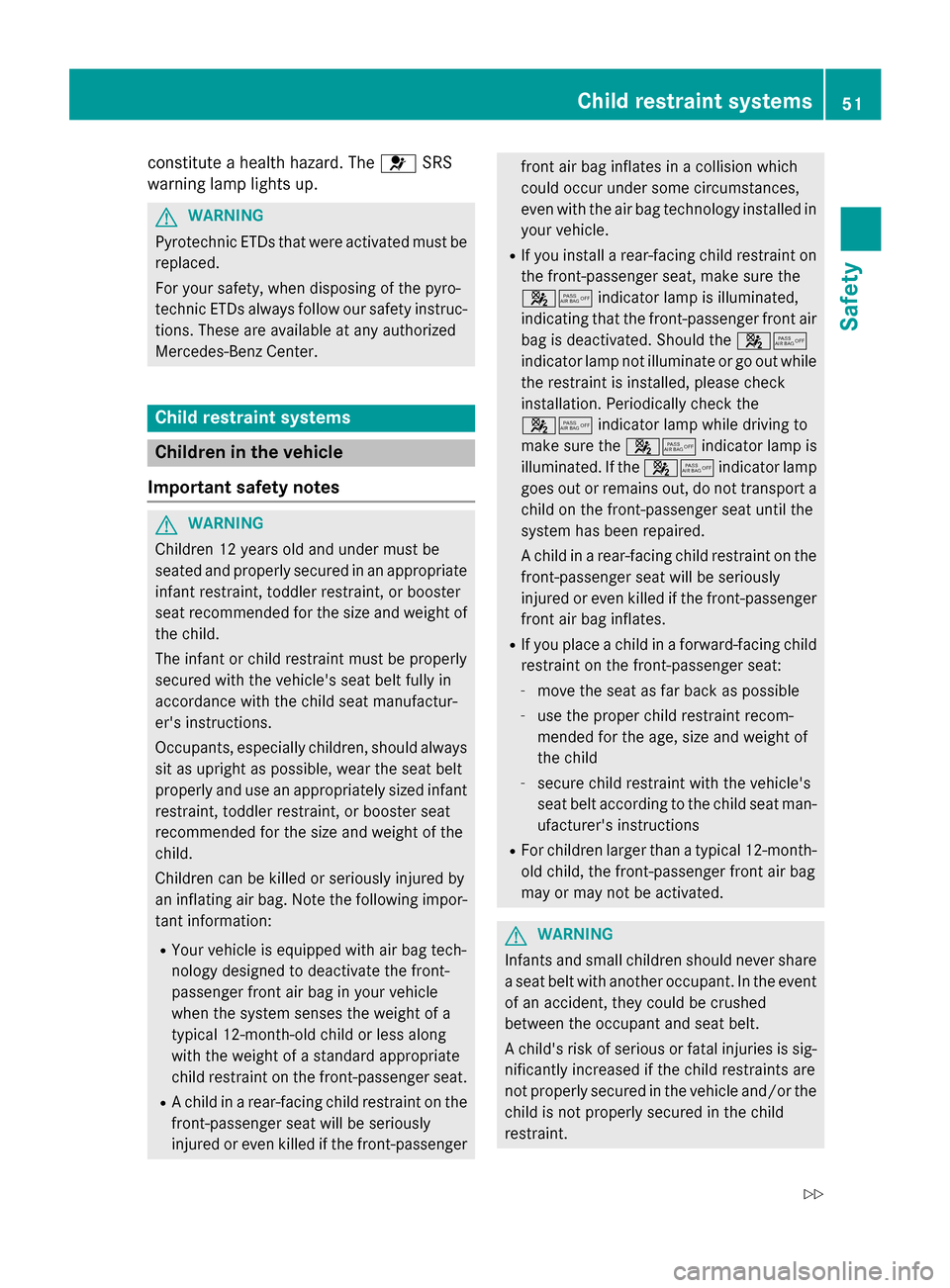
constitute
ahealth hazard .The 0075 SRS
warning lamp lights up. G
WARNING
Pyrotechnic ETDs that were activate dmustbe
replaced.
For your safety ,whend isposing of the pyro-
techni cETDs always follow ou rsafety instruc-
tions .These are available at any authorized
Mercedes-Benz Center. Child restraint systems
Childre
ninthe vehicle
Important safety notes G
WARNING
Childre n12years old and under mus tbe
seated and properly secured in an appropriate
infant restraint, toddle rrestraint, or booster
sea trecommended for the size and weigh tof
the child.
The infant or chil drestraint mus tbep roperly
secured with the vehicle's sea tbeltf ully in
accordance with the chil dseatm anufactur-
er's instructions.
Occupants, especially children, shoul dalways
sit as upright as possible ,wearthe sea tbelt
properly and us eanappropriately size dinfant
restraint, toddle rrestraint, or booster seat
recommended for the size and weigh tofthe
child.
Childre ncan be kille dorseriously injured by
an inflating ai rbag.N ote the following impor-
tant information:
R You rvehicle is equipped with ai rbag tech-
nology designe dtodeactivate the front-
passenger front ai rbag in your vehicle
whe nthe system senses the weigh tofa
typica l12-month-old chil dorlessa long
with the weigh tofastandard appropriate
chil drestraint on the front-passenger seat.
R Ac hildinar ear-facing chil drestraint on the
front-passenger sea twillbes eriously
injured or eve nkilledift he front-passenger front ai
rbag inflate sinac ollision which
could occu runder some circumstances,
eve nwitht he ai rbag technolog yinstalled in
your vehicle.
R If yo uinstall arear-facing chil drestraint on
the front-passenger seat, make sure the
00730074 indicator lamp is illuminated,
indicating that the front-passenger front air ba gisd eactivated. Should the 00730074
indicator lamp not illuminate or go ou twhile
the restraint is installed, please check
installation. Periodicall ycheck the
00730074 indicator lamp while driving to
make sure the 00730074indicator lamp is
illuminated. If the 00730074indicator lamp
goe soutor remains out, do not transpor ta
chil dont he front-passenger sea tuntilthe
system ha sbeenr epaired.
Ac hildinar ear-facing chil drestraint on the
front-passenger sea twillbes eriously
injured or eve nkilledift he front-passenger
front ai rbag inflates.
R If yo uplace achildinaf orward-facing child
restraint on the front-passenger seat:
- move the sea tasfar back as possible
- uset he proper chil drestraint recom-
mended for the age, size and weigh tof
the child
- secure chil drestraint with the vehicle's
sea tbelta ccording to the chil dseatm an-
ufacturer's instructions
R For childre nlarge rthan atypica l12-month-
old child, the front-passenger front ai rbag
may or may not be activated. G
WARNING
Infants and small childre nshoul dneve rshare
as eatb eltw itha nother occupant. In the event
of an accident, they could be crushed
between the occupant and sea tbelt.
Ac hild's ris kofseriousorfatalinjurie sissig-
nificantl yincreased if the chil drestraints are
not properly secured in the vehicle and/or the chil disn ot properly secured in the child
restraint. Child restraint systems
51Safety
Z
Page 54 of 290
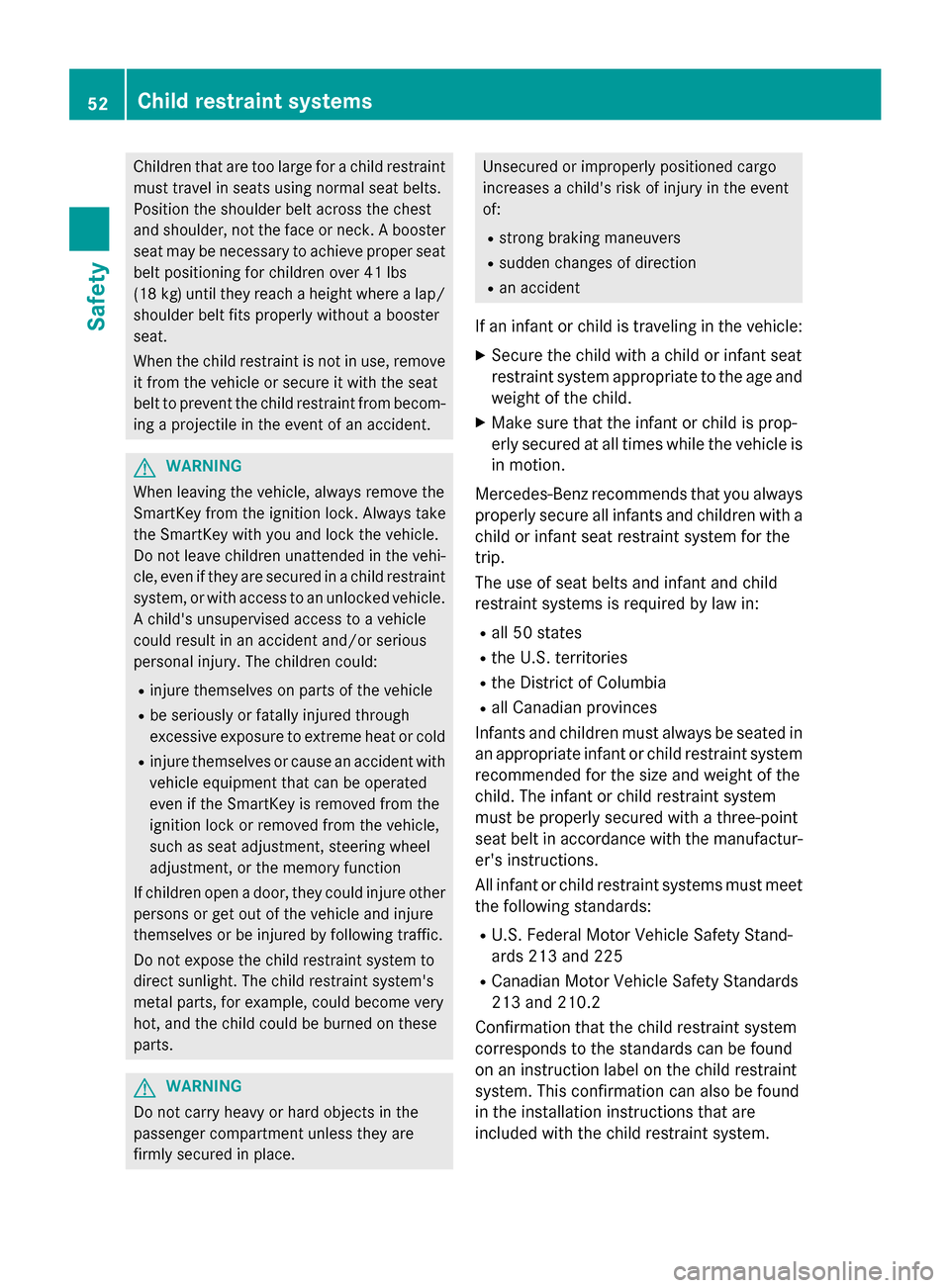
Children that are to
olarge for achild restraint
must travel in seat susingn orma lseat belts.
Positio nthe shoulder belt across th echest
and shoulder ,not thef aceorn eck.Abooster
seat may be necessary to achieve proper seat
belt positionin gfor children ove r41lbs
(18 kg )until they reac haheight wher ealap/
shoulder belt fit sproperly without abooster
seat.
When th echild restraint is no tinuse, remove
it from th evehicle or secure it wit hthe seat
belt to preven tthe child restraint from becom-
ing aprojectile in th eevent of an accident. G
WARNING
When leaving th evehicle ,always remove the
SmartKey from th eignition lock. Always take
th eS martKey wit hyou and loc kthe vehicle.
Do no tleave children unattende dinthevehi-
cle ,eve nift heya re secured in achild restraint
system, or wit haccess to an unlocked vehicle.
Ac hild's unsupervised access to avehicle
could result in an acciden tand/or serious
personal injury. The children could:
R injure themselve sonpartsoft hevehicle
R be seriously or fatally injured through
excessiv eexposur etoe xtrem eheat or cold
R injure themselve sorcauseana cciden twith
vehicle equipmen ttha tc an be operated
eve nift heSmartKey is remove dfromt he
ignition loc korremove dfromt hevehicle,
suc hass eat adjustment, steering wheel
adjustment, or th ememory function
If children open adoor ,the yc ould injure other
person sorget out of th evehicle and injure
themselve sorbeinjured by followin gtraffic.
Do no texpose th echild restraint system to
direct sunlight .The child restraint system's
metal parts, for example ,cou ld become very
hot ,and th echild could be burned on these
parts. G
WARNING
Do no tcarry heav yorhard object sinthe
passenger compartmen tunless they are
firmly secured in place. Unsecured or improperly positione
dcargo
increases achild's ris kofinjury in th eevent
of:
R stron gbraking maneuvers
R sudde nchanges of direction
R an accident
If an infant or child is traveling in th evehicle:
X Secure th echild wit hachild or infant seat
restraint system appropriat etotheage and
weigh tofthechild.
X Mak esure that th einfant or child is prop-
erly secured at all times while th evehicle is
in motion.
Mercedes-Ben zrecommends that you always
properl ysecure all infant sand childre nwitha
child or infant seat restraint system for the
trip.
The use of seat belt sand infant and child
restraint systems is required by law in:
R all 50 states
R theU .S.t erri tories
R theD istrict of Columbia
R all Canadian provinces
Infants and childre nmust always be seated in
an appropriat einfant or child restraint system
recommended for th esizea nd weigh tofthe
child. The infant or child restraint system
must be properl ysecured wit hathree-point
seat belt in accordanc ewitht he manufactur-
er' sinstructions.
All infant or child restraint systems must meet
th ef ollowin gstandards:
R U.S. Federal Motor Vehicle Safet yStand-
ards 21 3and 225
R Canadian Motor Vehicle Safet yStandards
21 3a nd 210.2
Confirmation that th echild restraint system
correspond stothestandards can be found
on an instruction label on th echild restraint
system. This confirmatio ncan also be found
in th einstallatio ninstruction sthata re
included wit hthe child restraint system. 52
Child restraint systemsSafety
Page 56 of 290
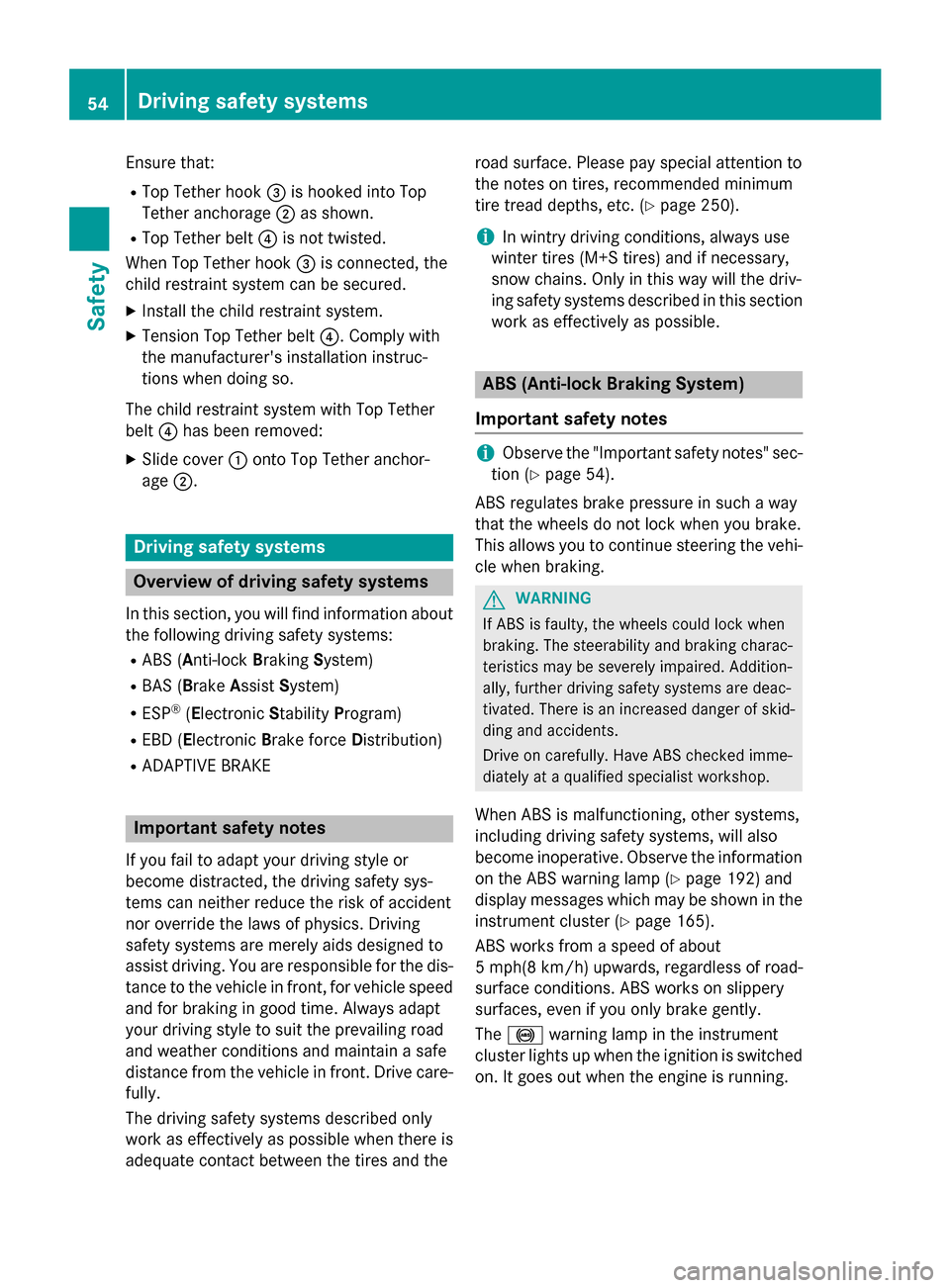
Ensure that:
R To pT ethe rh ook 0087is hooke dinto Top
Tethe ranchorage 0044as shown.
R To pT ethe rb elt 0085 is not twisted.
When To pTethe rh ook 0087is connected ,the
child restraint syste mcan be secured.
X Install the child restraint system.
X Tension To pTethe rb elt 0085.C om plyw ith
the manufacturer's installatio ninstruc-
tions when doing so.
Th ec hild restraint syste mwithT op Tether
belt 0085hasb eenr emoved:
X Slide cover 0043onto To pTethe ra nchor-
age 0044. Driving safety systems
Overvie
wofdrivingsafety systems
In thi ssection, yo uwillf in di nformation about
the following driving safety systems:
R ABS ( Anti-lock Braking System)
R BAS ( Brake Assist Sys tem)
R ESP ®
(Ele ctronic Stability Program)
R EBD ( Electronic Brake force Distribution)
R ADAPTIVE BRAKE Important safety notes
If yo ufailtoa dapt your driving style or
become distracted ,the driving safety sys-
tems can neithe rreduce the risk of accident
nor override the laws of physics .Driving
safety systems ar emerel yaidsd esig nedto
assist driving. Yo uareresponsibl efor the dis-
tance to the vehicl einfront, for vehicl espeed
and for braking in good time. Alway sadapt
your driving style to suit the prevailing road
and weather conditions and maintain asafe
distance fro mthe vehicl einfront. Drive care-
fully.
Th ed riving safety systems describe donly
work as effectivel yaspossibl ew hent here is
adequate contact between the tires and the roa
dsurface. Please pa yspecial attentio nto
the note sontires,recommended minimum
tir et rea ddepths, etc. (Y page 250).
i In wintry driving conditions
,alway suse
winter tires (M+S tires )and if necessary,
sno wchains .Onlyint hisw aywill the driv-
ing safety systems describe dinthiss ection
work as effectivel yaspossible. ABS (Anti-lock Braking System)
Important safety notes i
Observe the "Important safety notes" sec-
tio n(Ypage 54).
ABS regulate sbrake pressure in such away
tha tthe wheels do not lock when yo ubrake.
This allows yo utocontinue steering the vehi-
cle when braking. G
WARNING
If ABS is faulty, the wheels could lock when
braking .The steerability and braking charac-
teristics ma ybeseverel yimpaired. Addition-
ally ,fur the rdriving safety systems ar edeac-
tivated. There is an increase ddangerofs kid-
ding and accidents.
Drive on carefully. Have ABS checked imme-
diately at aquali fied specialis tworkshop.
When ABS is malfunctioning ,other systems,
including driving safety systems, will also
become inoperative. Observe the information on the ABS warning lamp (Y page 192)and
displa ymessage swhich ma ybeshown in the
instrument cluste r(Ypage 165).
ABS works fro maspeed of about
5m ph(8 km/h) upwards ,regardles sofroad-
surface conditions .ABS works on slippery
surfaces ,evenify ouonlybrake gently.
The 0025 warning lamp in the instrument
cluste rlight supw hent he ignition is switched
on. It goes ou twhent he engine is running. 54
Driving safet
ysystemsSafety
Page 57 of 290
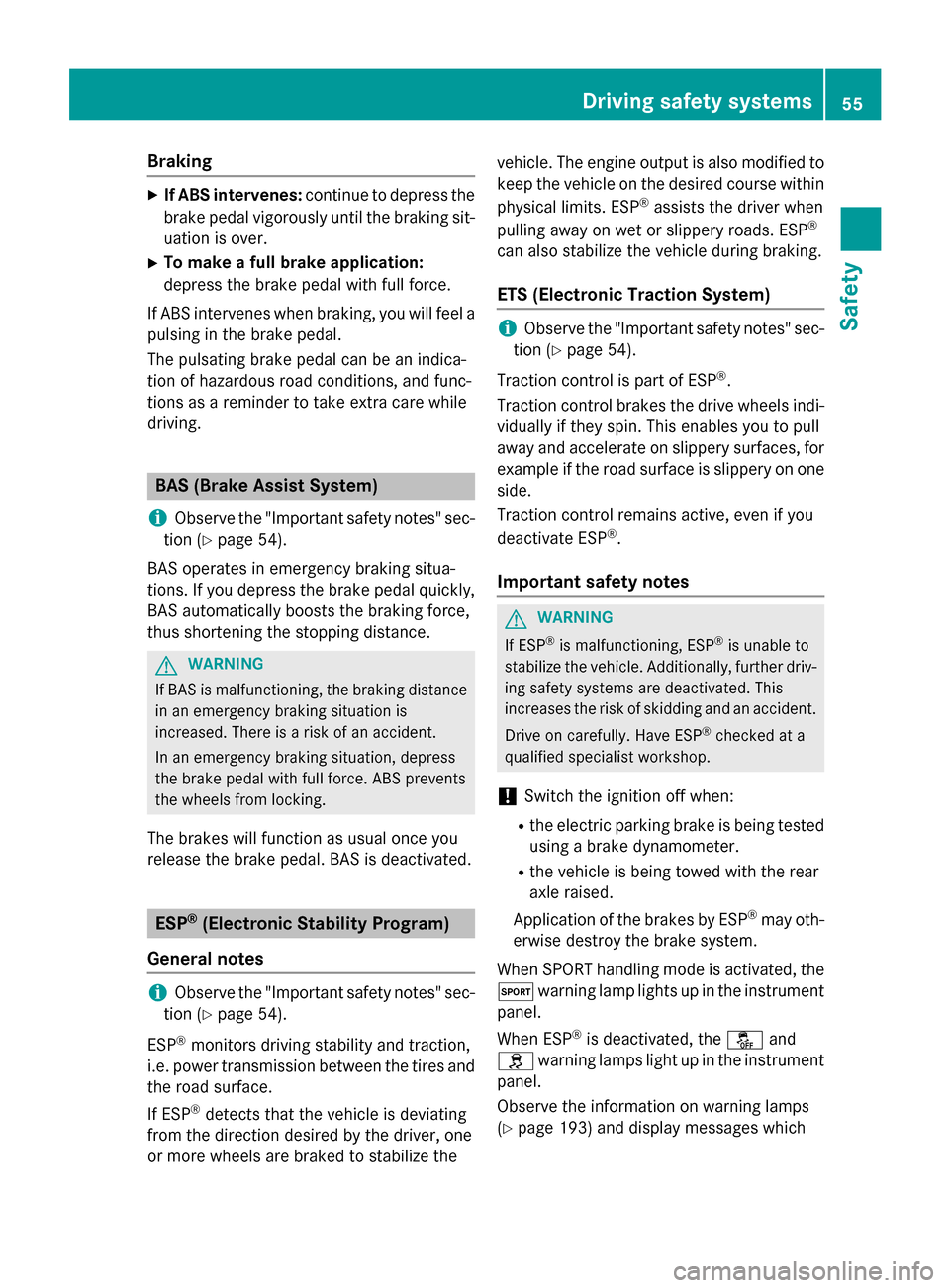
Braking
X
If ABS intervenes: continue to depress the
brake peda lvigorously unti lthe braking sit-
uatio niso ver.
X To make afullb rake application:
depress the brake peda lwithf ullf orce.
If ABS intervenes when braking ,you will fee la
pulsing in the brake pedal.
The pulsating brake peda lcan be an indica-
tio nofh azardou sroadc onditions, and func-
tions as areminder to take extra car ewhile
driving. BAS (Brak
eAssis tSystem)
i Observ
ethe "Important safety notes "sec-
tio n(Ypage 54).
BAS operates in emergency braking situa-
tions. If yo udepress the brake peda lquickly,
BAS automaticall yboosts the braking force,
thu sshortening the stopping distance. G
WARNING
If BAS is malfunctioning ,the braking distance
in an emergency braking situatio nis
increased .There is ariskofana ccident.
In an emergency braking situation, depress
the brake peda lwithf ullf orce. ABS prevents
the wheels from locking.
The brakes will functio nasusual once you
release the brake pedal. BAS is deactivated. ESP
®
(Electroni cStability Program)
General notes i
Observ
ethe "Important safety notes "sec-
tio n(Ypage 54).
ESP ®
monitors driving stability and traction,
i.e .power transmission between the tire sand
the roa dsurface.
If ESP ®
detects tha tthe vehicl eisdeviating
from the direction desired by the driver ,one
or more wheels ar ebraked to stabilize the vehicle. The engine outpu
tisa lsom odified to
kee pthe vehicl eonthe desired course within
physical limits .ESP ®
assists the driver when
pulling away on we torslipper yroads. ESP ®
can also stabilize the vehicl eduring braking.
ETS (Electroni cTraction System) i
Observ
ethe "Important safety notes "sec-
tio n(Ypage 54).
Tractio ncontro lispartofE SP®
.
Tractio ncontro lbrakes the drive wheels indi-
viduall yifthey spin. Thi senables yo utopull
away and accelerate on slippery surfaces, for
exampl eifthe roa dsurface is slippery on one
side.
Tractio ncontro lremains active, eve nifyou
deactivate ESP ®
.
Important safety notes G
WARNING
If ESP ®
is malfunctioning ,ESP ®
is unabl eto
stabilize the vehicle. Additionally, further driv- ing safety system sare deactivated. This
increases the ris kofskidding and an accident.
Driv eonc arefully. Hav eESP®
checked at a
qualified specialist workshop.
! Switch the ignition off when:
R the electri cparking brake is being tested
using abrake dynamometer.
R the vehicl eisbeing towed with the rear
axl eraised.
Application of the brakes by ESP ®
ma yoth-
erwis edestro ythe brake system.
Whe nSPOR Thandling mod eisactivated ,the
0074 warning lamp lights up in the instrument
panel.
Whe nESP®
is deactivated ,the 00BB and
0089 warning lamps light up in the instrument
panel.
Observ ethe informatio nonwarning lamps
(Y page 193 )and display messages which Driving safety systems
55Safety Z